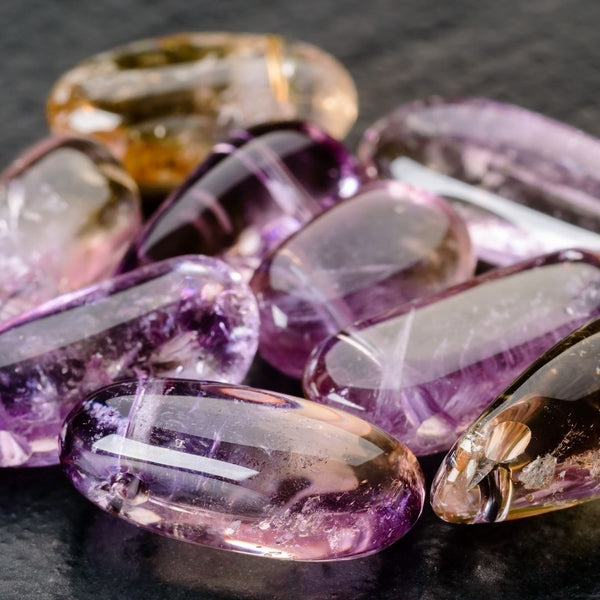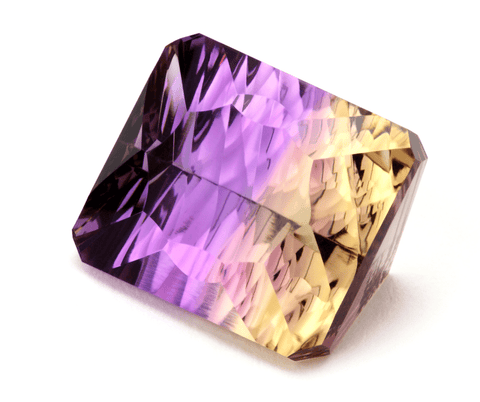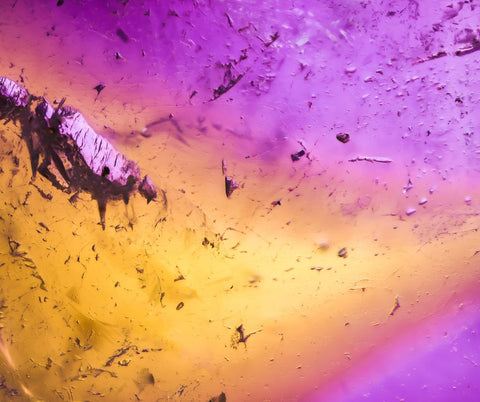If you aren’t familiar with ametrine, you aren’t alone. The ametrine crystal is generally considered rare, and many people never see a piece of it in person, which is a shame.
Overall, the ametrine gemstone is potentially one of the most intriguing crystals on the planet. Its unique colouring, often called amethyst citrine, isn’t found in nearly any other stone, causing it to stand out from the pack distinctly.
If you are curious about ametrine and its unique beauty, here’s what you need to know about this stone.
Ametrine Properties & Physical Characteristics
First, it’s crucial to understand that ametrine isn’t a gemstone; it’s a silica mineral. It’s part of the broader quartz family, with its main separating characteristic being the impurities that give the stone its colour.
Second, ametrine isn’t technically its own mineral. Instead, the stone occurs when amethyst and Citrine – both quartz minerals – are found together in the same sample. The presence of both crystals together is what makes a stone ametrine.
Fine ametrines generally have no eye-visible inclusions, which enhances their transparency and overall quality.
Geological Formation
Origin: Ametrine is formed in quartz veins in volcanic rocks. Its unique coloration is due to varying iron impurities and different oxidation states caused by different temperatures during the crystal's formation.
Colour Formation: The purple colour (amethyst) is due to the presence of iron impurities subjected to radiation from the surrounding rock, while the yellow/orange colour (citrine) results from heat treatment by volcanic activity or natural earth processes.

Ametrine is usually transparent, easily allowing light to pass through and even making it possible to view something positioned behind the stone. If there is a lack of transparency, it's usually due to an impurity or other stone being attached to the gem.
Raw or rough ametrine has a crystal-like shape, just as you'd expect to find in other quartz variants. This version is highly desirable for some, allowing the ametrine to maintain its natural look. However, ametrine also stands up well to cutting, faceting, tumbling, and polishing, so it's very common to find pieces of ametrine that have been shaped in various ways.
AMETRINE STONE COLOR: AMETHYST CITRINE
What makes ametrine intriguing is its colour combination. Natural ametrine features yellow and purple hues on opposite sides of the colour wheel, creating a lovely contrast.
The strength of the colour can vary. The most valuable pieces of ametrine have deep or jewel-toned purple and yellow portions, ensuring a dramatic contrast. Ametrine gemstones with lighter shades of purple or yellow aren’t as highly sought after, so they are more affordable. Due to internal reflections, some ametrine stones may appear mauve, peach, or rosy gold.

It is important to note that while natural ametrine crystals are for sale, there are also colour-treated stones. Sometimes, a process is applied to make the hues brighter or deeper to make less desirable stones more intriguing to buyers. In others, the procedure allows a piece to be altered, creating a unique gemstone that resembles ametrine even though the yellow portion didn’t occur naturally.
While some jewelry sellers offer green ametrine or other non-traditional colour variants, none are natural ametrine stones. Sometimes, these may be pieces of ametrine or another version of quartz that have undergone colour treatments, while others are synthetic or lab-created stones.
THE HISTORY OF AMETRINE
The history of ametrine is pretty straightforward. The stone gets its name by combining the names of the two other gems present, with the “ame-” coming from amethyst and the “-trine’ coming from citrine.
However, the stone may also be known by other names, including “bloviate” due to where it’s mined or “bicolored quartz” because it features two different quartz colours. The Anahi Mine in Bolivia is the main commercial source of gem-quality ametrine.

The ametrine gem is generally used for ornamental purposes, particularly jewelry. Part of the reason it grew in popularity as a jewelry gemstone was the broad interest in bicolor. This led some stone cutters to begin faceting ametrine pieces that were half amethyst and half citrine, with the colour boundary straight and centred.
WHERE IS AMETRINE FOUND?
Ametrine is only found in a specific part of eastern Bolivia. Today’s commercial ametrine comes from a single mine, the Anahi Mine, which isn’t far from the country’s border with Brazil. There, both citrine and amethyst naturally occur, and when a piece of crystal is removed that features a bit of each stone, it’s classified as an ametrine. This unique combination provides the benefits of both amethyst and citrine in one stone.
There’s a legend associated with the Anahí Mine. It’s said that a Spanish conquistador received the mine as a dowry when he married a native princess from the Ayoreo tribe in Bolivia. He brought ametrine back to Europe, introducing this gemstone to the Western world.
The world’s supply of ametrine is ultimately finite. As a result, high-quality specimens can be worth quite a bit. However, the ametrine crystal is affordable and often far less expensive than the bicolored tourmaline that inspired its use in jewelry.
AMETRINE JEWELRY

While you won’t likely find ametrine in chain jewelry stores, independent jewelry designers often enjoy featuring the stone. Its unique colouring is almost always striking, and many appreciate the dramatic contrast, making the jewelry pieces featuring it fairly popular. Many designers also offer custom designs for personalized and unique ametrine jewelry.
For anyone seeking an ametrine pendant or a natural ametrine ring, there are two options for the stone. Both faceted gems and cabochons are available, and you may even find some featuring raw or rough ametrine crystal with little, if any, shaping.
If you’re looking for an ametrine bracelet, options featuring ametrine gemstone beads are reasonably available. You may also find beads in strand necklaces and certain ametrine earrings.
However, it’s important to note that bead strands marketed as ametrine may feature a combination of amethyst and citrine beads without any beads featuring both stones. Technically, a bead isn’t ametrine if it doesn’t contain both crystal types, so keep that in mind when looking for jewelry.
Ametrine Metaphysical Properties and Benefits
Ametrine inherits metaphysical properties from both stones as a naturally occurring blend of amethyst and citrine. It is highly valued in various spiritual and healing circles for its unique combination of energies. Here's a breakdown of its metaphysical properties and perceived benefits:
Ametrine Metaphysical Properties

Balance and Harmony: Ametrine is believed to embody the balance and harmony of its constituent stones, amethyst and yellow citrine, bringing together masculine and feminine energies, intellectual and emotional strengths, and physical and spiritual aspects.
Cleansing and Protection: Like amethyst, ametrine is thought to have a cleansing and highly protective crystal energy, helping to clear negative energies from the environment and one's aura.
Abundance and Prosperity: Citrine-derived ametrine is often associated with attracting abundance, wealth, and success.
Enhanced Mental Clarity: It is said to stimulate the intellect, clear stress and tension from the head, calm the mind, and help in decision-making processes.
Spiritual Growth: Ametrine encourages spiritual growth and enlightenment, often used to deepen meditation and enhance intuition.
Perceived Benefits of Ametrine
Emotional Well-Being: It's believed to help balance emotions, promote emotional stability, and relieve depression and anxiety.
Creativity and Inspiration: Ametrine is thought to stimulate creativity, making it popular among artists, writers, and anyone involved in creative pursuits.
Physical Health: While not a substitute for medical treatment, in crystal healing, ametrine is sometimes used to aid digestion, boost energy levels, and support the immune system.
Career and Business: People use ametrine to attract success in business endeavours, improve concentration, maintain emotional self-control and foster a good work environment.
Relationships: Its balancing energy is also said to be helpful in relationships, fostering understanding and harmony.
Using Ametrine
Meditation and Yoga: Used during meditation or yoga, ametrine can help in achieving a deeper state of relaxation and clarity.
Jewelry: Wearing ametrine jewelry is thought to continuously impart energetic benefits to the wearer.
Placement in Home or Workplace: As a decorative element, it is believed to maintain a delicate balance of energies in a space, promoting a positive atmosphere.
It's important to note that ametrine's metaphysical properties and benefits, as with any crystal, are largely based on belief systems and personal experiences rather than scientific evidence. People are drawn to ametrine for its aesthetic beauty and the well-being they derive from its energy. Whether or not one subscribes to these beliefs, ametrine remains a fascinating and beautiful gemstone.
Ametrine Healing Properties

Like many gemstones, Ametrine is believed by some crystal healing practitioners to possess physical healing properties. These beliefs are part of alternative or metaphysical healing practices and are not supported by mainstream scientific evidence. However, they are integral to certain holistic and spiritual healing traditions. Here are some of the physical healing associations attributed to ametrine:
Stress and Tension Relief: Ametrine is said to be effective in alleviating stress and tension, potentially aiding in the relaxation of muscles and nerves.
Digestive Health: It is sometimes used to improve digestion, possibly by positively influencing the solar plexus chakra, which is associated with gut health.
Immune System Support: Some believe that ametrine can bolster the immune system, helping the body in its natural defence mechanisms.
Chronic Conditions: There are claims that ametrine can help deal with chronic fatigue syndrome and treat arthritis and depression, although these claims lack scientific backing.
Detoxification: Ametrine is also associated with detoxifying the body, believed to aid the liver and endocrine system.
Pain Relief: Some users turn to ametrine for pain relief, particularly headaches and migraines, drawing on the stone’s purported calming energy.
Metabolism and Energy Levels: It’s occasionally used to boost metabolism and increase energy, potentially helpful for those experiencing lethargy or fatigue.
Some imitations of ametrine use natural materials chosen to impersonate the gemstone.
Usage in Healing Practices
Direct Contact: The stone is often placed directly on the body or the specific part that needs healing during a crystal healing session.
Wearing as Jewelry: Wearing ametrine jewelry is another way people seek to gain its healing benefits, allowing for continuous exposure to the stone's energy.
Disclaimer and Perspective
It's essential to approach these beliefs with a balanced perspective. While many people find comfort and personal value in using crystals like ametrine for physical and emotional healing, these practices should not replace conventional medical treatment. Professional healthcare advice should always be sought for physical ailments. The healing properties attributed to gemstones in crystal healing are part of a spiritual and holistic worldview and are not validated by modern medical science.
How to Care for Ametrines

Caring for and cleansing ametrine is important to maintain its physical beauty and vibrational properties for those who believe in crystal energies. Like other quartz crystal varieties, Ametrine rates a seven on the Mohs scale of hardness, making it relatively durable but susceptible to scratches and damage if not handled properly. Here's how you can care for and cleanse your ametrine:
Basic Care
Avoid Harsh Chemicals: Keep ametrine away from harsh chemicals and household cleaners. Exposure can damage the stone or affect its colour.
Protect from Scratches: To prevent scratches, store ametrine separately from other gemstones. A soft pouch or a fabric-lined jewelry box is ideal.
Avoid Extremes: Sudden temperature changes and prolonged exposure to intense heat or light can damage ametrine. Avoid leaving it in direct sunlight for extended periods, as it can fade the colour.
Cleaning Ametrine
Gentle Washing: Clean ametrine with lukewarm water and a mild soap. Use a soft brush, like a toothbrush, to gently scrub the stone and setting.
Rinse Thoroughly: Ensure all soap is rinsed off, as residue can leave a film on the stone.
Dry Carefully: Pat dry with a soft, lint-free cloth.
Energetic Cleansing of Ametrine
For those who use ametrine for its metaphysical properties, regular energetic cleansing is believed to clear the stone of any absorbed negativity and rejuvenate its natural energies. Several methods of energy cleansing can be used:
Water Cleansing: Briefly run the stone under running water (tap water is fine), visualizing the water clearing away negative energy. Be cautious with water temperature and exposure time.
Moonlight: Place ametrine under the moonlight overnight, especially during a full moon, for a gentle and thorough cleansing.
Smudging: For a traditional smudging cleanse, pass the stone through the smoke of a sage stick or palo santo.
Sound Cleansing: Use singing bowls, bells, or chanting to cleanse ametrine with sound vibrations.
Other Crystals: Place ametrine on a bed of clear quartz or amethyst, as these crystals are believed to cleanse and recharge other stones.
Regular Maintenance
Periodic Inspection: If your ametrine is set in jewelry, periodically inspect the settings to ensure the stone's security.
Professional Cleaning: For valuable pieces, professional cleaning and inspection are recommended.
Caution
Avoid Ultrasonic and Steam Cleaners: These cleaning methods can damage ametrine, especially if it has inclusions or fractures.
In summary, the care and cleansing of ametrine involve both practical steps to maintain its physical condition and, for those inclined, metaphysical practices to keep its energetic properties vibrant. Whether you view ametrine as a beautiful gemstone or a tool for spiritual practice, proper care will ensure its longevity and beauty.
STONES SIMILAR TO AMETRINE
Overall, there aren’t many strong substitutes for ametrine. Bicolored stones are rare, and you won’t have much luck finding alternatives that feature yellow and purple specifically.
The only exception may be certain pieces of bicolored tourmaline. While purple tourmaline isn’t usually found with yellow, certain yellow and pink bicolored tourmaline crystals look like ametrine. The issue is that they cost more than ametrine, which may not be ideal.
Large ametrine material is popular with gem carvers for their creations.
Otherwise, the only solid alternatives tend to be synthetic or lab-created. But with ametrine usually being reasonably affordable, it may make more sense to stick with the real deal if you want a stone featuring that particular look.
Frequently Asked Questions About Ametrine

Is ametrine a rare gemstone?
Ametrine is relatively rare in its natural form. The most significant source is the Anahí Ametrine Mine in Bolivia. While other sources of quartz exhibit a mixture of purple and yellow hues, the distinct and natural bicolor characteristic of Bolivian ametrine, where the colours are divided within the crystal, is less common. However, this rarity is specific to natural ametrine; synthetic ametrine, created by artificially combining amethyst and citrine, is more readily available.
Is ametrine an expensive stone?
The price of ametrine can vary. Natural, high-quality ametrine with a clear and distinct separation of purple and yellow colours and without inclusions can be considered valuable and fetch higher prices. However, compared to many other gemstones, ametrine is generally more affordable. The cost can also depend on factors such as the intensity of the colours, the size of the stone, and the quality of the cut. Synthetic or treated ametrine is typically less expensive than natural ametrine.
How can you tell if ametrine is real?
Determining if ametrine is real (natural) involves examining several aspects:
-
Colour Zones: The transition between yellow and purple colours is typically quite abrupt in natural ametrine. Synthetic versions may show more blended colours.
-
Inclusions: Natural ametrine may have inclusions or minor imperfections, which are less common in synthetic stones.
-
Temperature Test: Natural ametrine will typically feel cool to the touch.
-
Professional Testing: A gemologist can examine the stone using tools like a refractometer or a microscope to definitively identify it.
What chakra is ametrine good for?
Ametrine is believed to be beneficial for several chakras due to its combination of amethyst and citrine properties:
-
Solar Plexus Chakra: The citrine component of ametrine is associated with the solar plexus chakra, believed to aid in self-confidence and personal power.
-
Crown Chakra: The amethyst aspect is linked with the crown chakra, enhancing spiritual awareness and wisdom.
-
Third Eye Chakra: Some also believe ametrine stimulates the third eye chakra, promoting intuition and psychic abilities.
By integrating the qualities of amethyst and citrine, ametrine is thought to harmonize physical and spiritual awareness, making it a versatile stone in chakra-based practices.









